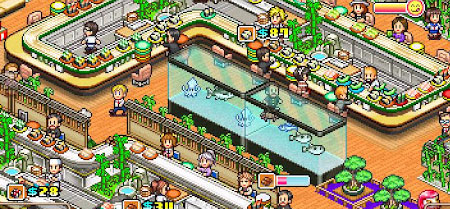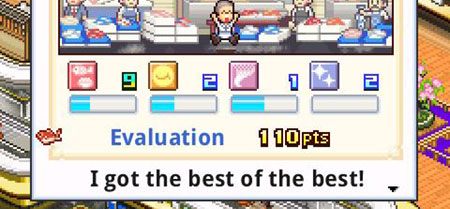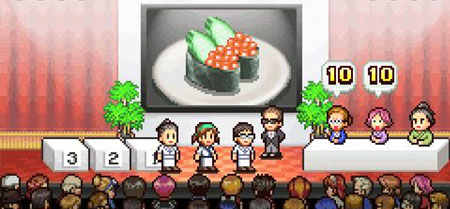You can't accuse Kairosoft of not considering all areas and angles for its management games. You've got your more typical sims, sure, with city and football games, but then the studio throws a complete curveball.
It's latest release,
The Sushi Spinnery, is one such "out there" title. With its foreign sushi restaurant theme, you may find that you need a little more help than normal.
We can't exactly claim to have a great understanding of how sushi restaurants work. But we have plugged many hours into this game and we're back with hints and tips to divulge.
Don't know your Tamago from your Menegi? Then read on for wisdom and guidance.
Conveyor panic
Your conveyor belt is, obviously, the most important element to your restaurant. It's where all your customers come to sit and eat, and can be shaped however you want.
Now, it might seem like a good idea to simply expand its edges further throughout play as your customer demand increases. However, if you're thinking a big square or rectangle is a good idea, the maths is not on your side.
The key is to maximise the perimeter of your conveyor belt, not the area. All the area inside of the conveyor belt loop that isn't taken up by prep stations is potential wasted space, and so you need to consider what is the best way to weave your belt such that it utilizes as much of this space as possible.
Instead of making a big round shape, weave the belt up and down your restaurant, such that it goes from one end of your restaurant to the other, then immediately does a u-turn and comes straight back down the other side. Keep weaving it back and forth like this, such that your customers are sitting back-to-back.
PreppedPrep stations are also an important factor, and can be cleverly placed such that you minimise the time it takes to get food to your customers.
Count how many seats you have around your conveyor belt, then place prep stations such that you have one every, say, five seats. That way, you'll minimise how often a customers gets angry at the lack of service and leaves early.
Also note that you can have two different types of chef at each prep station - one of your hired chefs, or a part-timer. Part-timers don't work as well as normal chefs, but don't cost any monthly wages.
They're great for when you can't yet hire enough chefs (the game lets you unlock more staff positions later on) and for when you need someone to fill in when a chef goes to research a new recipe.
Note that later into the game can you upgrade your part-timers to make them more capable - you should try to go this as soon as possible, but be wary that this can cost a lot of sushi coins.
Special service
One area of play that you always need to keep an eye on is your Specials menu.
At any time, you can choose two of your dishes to be the "specials". This means that these dishes will be created more often than other meals, in the hope that more customers will grab them off the belt.
Certain ingredients and types of dish are more popular depending on the current season, and these must-have meals are denoted by a small wiggling fish next to the dish in the list.
When a dish is popular, its price doubles - hence, you want to make sure that your Specials are always these popular dishes to maximise your cash flow.
Contestion chargeContests are one of the main ways to push the game forward, but it can be tricky to win the first prize in each one.
The key to winning is to satisfy exactly what the judges are looking for. Touching a contest will let you know exactly what is needed, be it flavour, texture, aroma or colour, while scrolling down will show you whether it will be judged by adults, kids or youths.
Once you've checked out what is required of you, head to the Dishes tab and choose to develop a new dish. Now read through each description of each base and work out which you need - for example, if you need to maximise flavour for the contest, you may want to pick Nigirizushi.
Now scroll through the dishes available, and once again choose the dish that has the highest stats for the particular element you need. Make sure you take into account how compatible each dish is with the gender and type of the judges too.
Finally, bang on the best toppings for the job, again looking to maximise the element you're looking to boost. By focusing on the one element you're after, that should do the trick of scoring 10s from the judges.
And the rest

Amenities are a great way to score a bit more cash here and there. Customers will usually choose to utilize amenities if they are nearby to their seat at the conveyor belt, so keep this in mind when placing them down.
The quality of the seating around the belt corresponds to how long a customer will stick around and continue eating. Improve the quality of seating through a two-pronged attack: place decor close by, and make sure you have chef with great stats to give customers more confidence in the food.
Take part in lots of PR campaigns to unlock more types of customers and therefore boost your cashflow. Don't bother with the Magazine Ad though, as that barely makes a difference.
Don't forget to keep purchasing new ingredients every now and again too, so that it's easier to win contests later into the game.









 Escape Game: “The Blood-stained Mansion”: Walkthrough
Escape Game: “The Blood-stained Mansion”: Walkthrough Icon Pop Mania Answers to All Levels
Icon Pop Mania Answers to All Levels Blood Brothers 2 - Tips, Cheats, and Strategies for a Happy War
Blood Brothers 2 - Tips, Cheats, and Strategies for a Happy War Lazors – Complete Walkthrough Tricky Level 1-10
Lazors – Complete Walkthrough Tricky Level 1-10 Guess The 2000s Answers All Levels
Guess The 2000s Answers All Levels